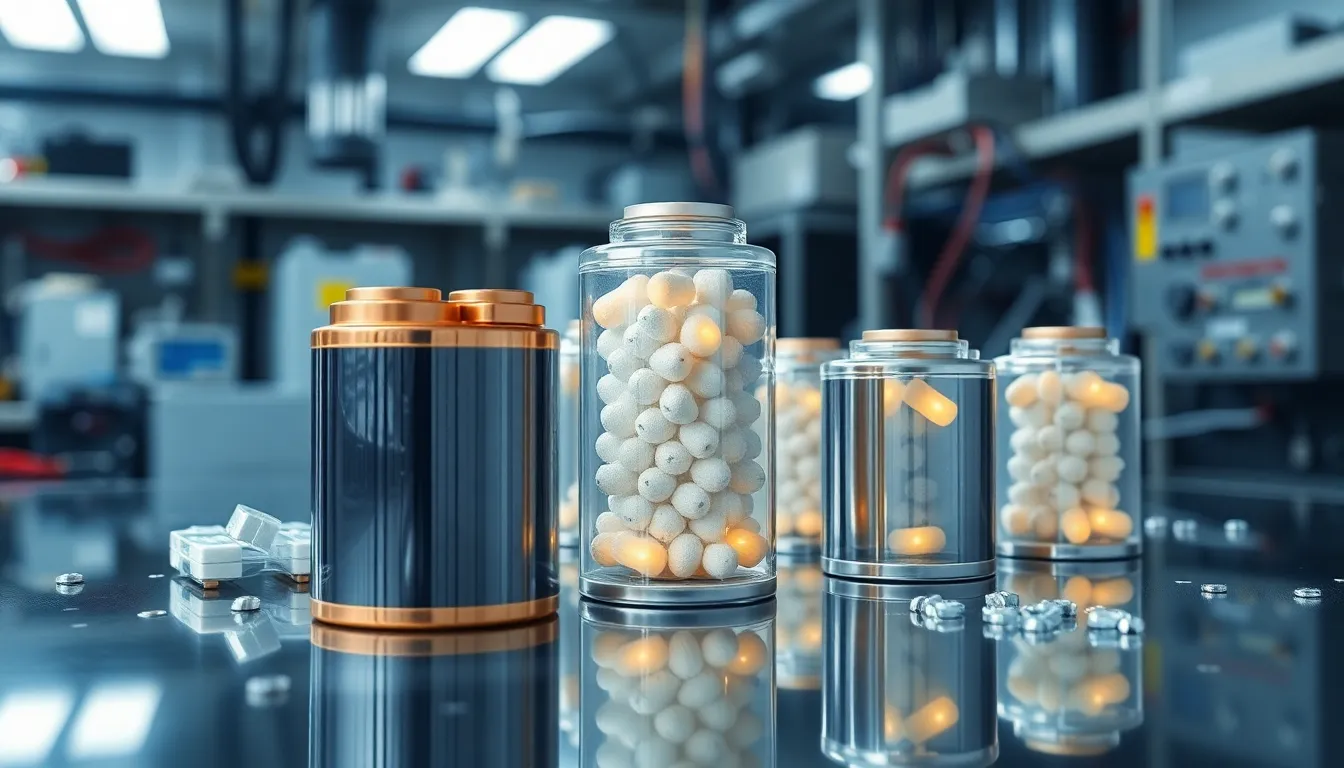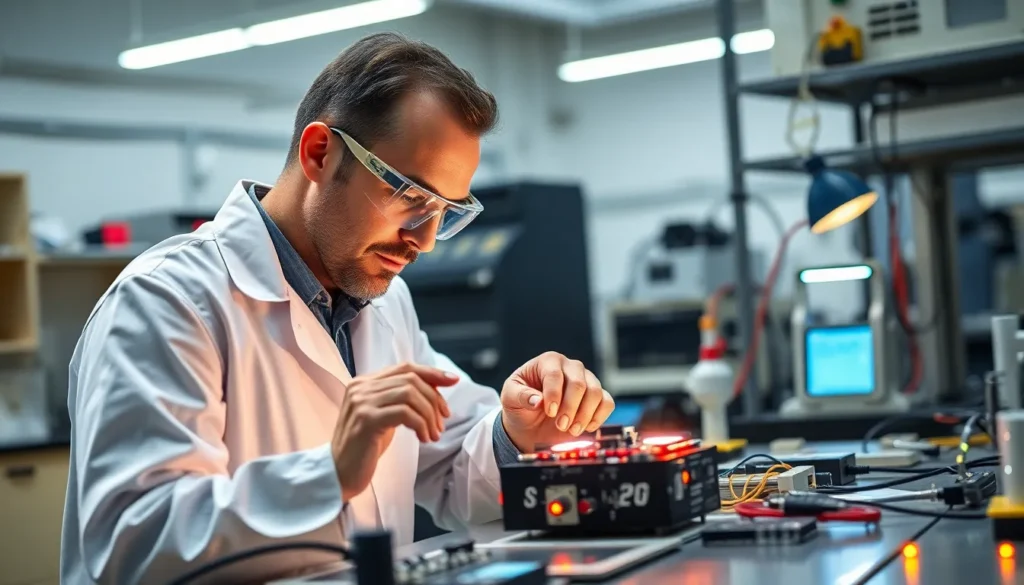As the world shifts towards sustainable energy solutions, next-generation battery technology is emerging as a game-changer. With the increasing demand for electric vehicles and renewable energy storage, innovative battery solutions promise to enhance efficiency, longevity, and safety. These advancements could redefine how energy is stored and consumed, paving the way for a greener future.
Researchers and companies are exploring various materials and designs, from solid-state batteries to lithium-sulfur options. Each development brings unique benefits that could significantly impact industries ranging from automotive to consumer electronics. As this technology evolves, it holds the potential to not only improve performance but also reduce environmental impact, making it a crucial topic for anyone invested in the future of energy.
Table of Contents
ToggleOverview of Next-Generation Battery Technology
Next-generation battery technology includes advanced energy storage solutions with enhanced performance characteristics. Solid-state batteries represent a major innovation, replacing liquid electrolytes with solid ones. This shift increases energy density, improves safety by reducing flammability, and extends battery life. Research indicates that solid-state batteries can deliver up to 50% more energy compared to conventional lithium-ion counterparts.
Lithium-sulfur batteries also contribute to this evolution. They utilize sulfur as a cathode material, allowing for higher energy capacity, potentially enabling electric vehicles to travel up to 500 miles on a single charge. The increased availability of raw materials like sulfur compared to cobalt significantly cuts costs and promotes sustainability.
Innovations in manufacturing processes aim to enhance battery scalability while reducing production costs. These processes include advanced materials engineering and automation technologies. As a result, industries such as automotive and consumer electronics benefit from more efficient supply chains and improved product performance.
Lastly, the integration of artificial intelligence (AI) in battery management systems optimizes charging cycles and monitors health conditions. AI-driven analytics can predict battery life and performance under various operational conditions, ensuring efficient energy usage and maximizing longevity.
Types of Next-Generation Batteries

Next-generation batteries include various innovative technologies designed to enhance energy efficiency and support sustainable energy solutions. The following types represent significant advancements in the battery industry.
Solid-State Batteries
Solid-state batteries utilize solid electrolytes instead of liquid ones, improving energy density by up to 50%. These batteries feature higher thermal stability, reducing the risk of flammability associated with traditional lithium-ion batteries. Solid-state batteries also exhibit longer life cycles, promising up to 1,000 charge-discharge cycles without significant capacity loss. Companies such as QuantumScape and Toyota are making notable progress in developing commercial solutions, aiming for broader applications in electric vehicles and portable electronics.
Lithium-Sulfur Batteries
Lithium-sulfur batteries employ sulfur as a cathode material, drastically reducing cost and improving sustainability. These batteries can potentially deliver energy densities of up to 500 Wh/kg, allowing electric vehicles to travel extensive distances on a single charge. With abundant and environmentally friendly resources, lithium-sulfur technology fosters a greener alternative to traditional lithium-ion batteries. Companies like Oxis Energy are advancing this technology, focusing on scalability and efficiency for commercial viability in various applications.
Advantages of Next-Generation Battery Technology
Next-generation battery technology offers significant benefits over traditional systems, enhancing efficiency and sustainability. Key advantages include improved energy density and faster charging times.
Improved Energy Density
Next-generation batteries, particularly solid-state and lithium-sulfur types, provide higher energy densities. Solid-state batteries can achieve up to 50% more energy density compared to conventional lithium-ion batteries, enabling greater storage capabilities in smaller formats. Lithium-sulfur batteries can deliver energy densities of up to 500 Wh/kg, facilitating longer range for electric vehicles. Such improvements grant manufacturers the potential to produce lighter, more compact batteries, which directly support the push for both electric vehicles and renewable energy systems.
Faster Charging Times
Next-generation battery technology leads to significantly reduced charging durations. Solid-state batteries can attain full charges in under one hour, minimizing downtime for electric vehicles and portable devices. Lithium-sulfur batteries also exhibit rapid charging capabilities, thanks to their superior chemical composition. This feature enhances user convenience and encourages widespread adoption of electric vehicles, making them more appealing to consumers who prioritize efficiency.
Challenges Facing Next-Generation Battery Development
Next-generation batteries face several challenges that hinder their development and widespread adoption. Key concerns include cost and manufacturing limitations, along with scalability issues.
Cost and Manufacturing Concerns
Cost remains a critical barrier in the development of next-generation battery technologies. Solid-state and lithium-sulfur batteries require advanced materials and intricate manufacturing processes. For instance, solid-state batteries often involve expensive solid electrolytes and complex fabrication techniques. These factors contribute to higher initial production costs compared to conventional lithium-ion batteries. Additionally, investing in new production facilities or retrofitting existing plants presents a financial risk for manufacturers. As companies like QuantumScape and Oxis Energy work towards commercialization, reducing manufacturing costs while maintaining quality will be essential for market feasibility.
Scalability Issues
Scalability presents another significant challenge for next-generation battery technologies. Solid-state batteries and lithium-sulfur batteries must achieve mass production to meet the growing demand for electric vehicles and renewable energy storage. Current manufacturing processes may not efficiently scale, leading to potential bottlenecks. Large-scale production of solid-state batteries faces challenges in achieving consistent material quality, impacting overall performance. Similarly, lithium-sulfur batteries need advancements in production methods to ensure reliable output and higher yields. Addressing these scalability issues is vital for enabling broader adoption across various applications, including automotive and consumer electronics markets.
Future Trends in Battery Technology
Next-generation battery technology is evolving rapidly, showcasing several key trends that promise to transform energy storage solutions.
Enhanced Energy Density
Enhanced energy density represents a major focus in battery development. Solid-state batteries show up to 50% higher energy density than conventional lithium-ion counterparts. Lithium-sulfur batteries could reach energy densities of 500 Wh/kg, allowing electric vehicles to cover extended distances without increasing battery size. Companies like QuantumScape are concentrating on maximizing energy storage capabilities, catering to consumer demands for longer ranges.
Fast Charging Solutions
Fast charging capabilities are pivotal for user convenience. Next-generation batteries can achieve full charges in under one hour, significantly reducing downtime for electric vehicles and portable devices. Enhanced charging technologies, including ultra-fast chargers compatible with solid-state batteries, contribute to increasing adoption rates among consumers. Companies are innovating to minimize the wait time for users while maintaining battery health.
Sustainable Materials
Sustainable materials play a crucial role in the future of battery technology. Lithium-sulfur technology promotes eco-friendliness by utilizing more abundant and less harmful resources. As environmental concerns rise, manufacturers prioritize sourcing materials that align with sustainability goals, improving the lifecycle impact of batteries. Innovation in recycling processes also aims to recover valuable components from spent batteries, further enhancing sustainability.
Artificial Intelligence Integration
Artificial intelligence integration enhances battery performance management. AI-powered systems optimize charging cycles, effectively extending battery life and improving safety. Companies are deploying algorithms that analyze real-time data from battery management systems, predicting maintenance needs and ensuring operational efficiency. As AI continues to evolve, its applications within battery technology will increase.
Scalability Solutions
Scalability remains a critical focus for manufacturers. Streamlining production processes and reducing materials costs are essential for supporting mass production. Innovations, such as automated assembly lines and improved supply chain management, are emerging to address these challenges. Successful commercialization of next-generation batteries hinges on the ability to scale efficiently without compromising quality.
Global Collaborations
Global collaborations are shaping the battery technology landscape. Partnerships between manufacturers and research institutions strengthen innovation efforts and accelerate development timelines. Collaborative initiatives, like government-sponsored research programs, encourage sharing of knowledge and resources, driving advancements in next-generation battery technologies.
These collective trends indicate a pivotal shift in battery technology, reflecting the growing demand for efficient, sustainable energy storage solutions.
Next-generation battery technology is set to revolutionize the energy landscape. With advancements in solid-state and lithium-sulfur batteries, the potential for enhanced efficiency and sustainability is immense. These innovations promise longer life cycles and greater energy densities, addressing the growing demand for electric vehicles and renewable energy storage.
As companies continue to tackle the challenges of cost and scalability, the path to widespread adoption becomes clearer. The integration of artificial intelligence in battery management systems further optimizes performance and longevity. With ongoing research and development, the future of energy storage is not just promising but essential for a sustainable world.




